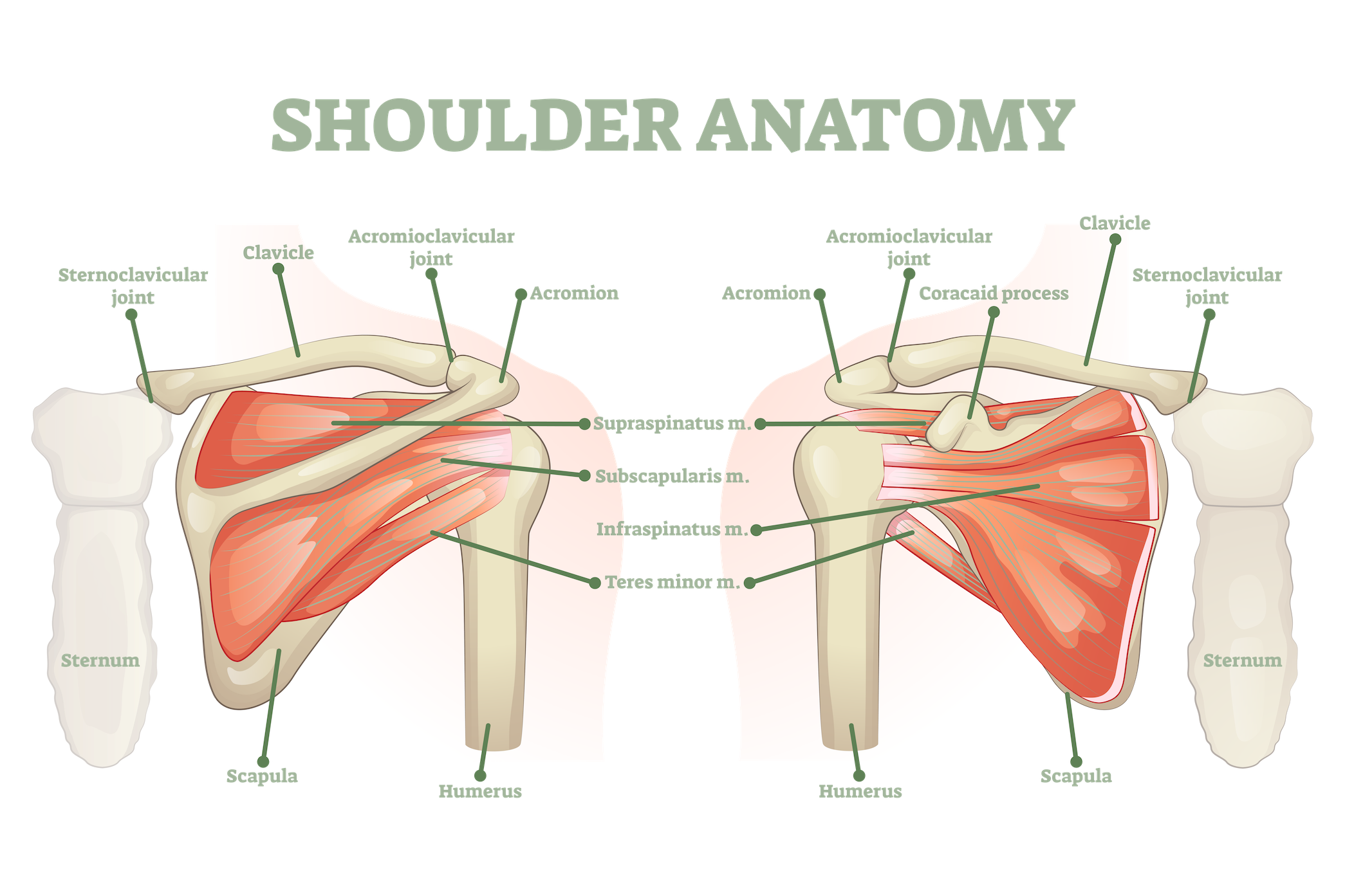If your shoulder press is hurting your shoulder joint, you’re not alone. This pain often comes from technique errors, muscle weaknesses, or overuse. In this post, we’ll dive into why this happens and how you can fix it to keep lifting pain-free.
Key Takeaways
- Common causes of shoulder pain during overhead presses include improper technique, muscle weakness, and overuse.
- Proper form, including controlled motions and appropriate hand and elbow positions, is crucial for pain-free shoulder presses.
- Strengthening supporting muscles and performing effective warm-up routines can significantly reduce the risk of shoulder injuries.
Common Causes of Shoulder Pain During Shoulder Press
Shoulder pain is often experienced by weightlifters while doing overhead presses. It is a common concern in this type of exercise. The shoulder joint is susceptible to injuries due to its complex structure and high mobility. Improper technique, muscle weakness or imbalance, and overuse are the primary culprits behind shoulder pain. Identifying these causes can help prevent long-term issues and enhance your lifting experience.
Incorrect Technique
Excessive back arching and flaring elbows are common causes of shoulder pain during overhead presses. Proper form ensures effective engagement of the shoulder muscles. Excessive back arching can place unnecessary strain on the lower back, while flaring elbows can lead to undue stress on the shoulder joint.
Slow and controlled movements during shoulder presses minimize the risk of injury. Weights should be lifted and lowered deliberately and steadily. Controlled movements not only prevent sudden jerks but also enhance muscle engagement, leading to safer and more effective workouts.
Muscle Weakness or Imbalance
Weak or unbalanced shoulder muscles can lead to overcompensation by other muscles, resulting in discomfort and potential injury. Incorporating targeted exercises to strengthen these muscles can help prevent imbalances and ensure proper shoulder function.
Overuse and Fatigue
Frequent overhead presses without adequate rest can result in muscle fatigue. This may also lead to overuse injuries in the shoulder muscles. Adjusting the range of motion during shoulder presses can help avoid pain and reduce the risk of injury.
Listening to your body and avoiding pushing through pain is crucial to prevent long-term damage, as ignoring it may lead to causing pain.
Understanding Shoulder Joint Mechanics
Understanding shoulder joint mechanics helps in preventing pain and enhancing performance. This highly mobile ball-and-socket joint relies on surrounding muscles and tendons for stability. Weakness or imbalance in these supporting muscles can lead to reduced function and discomfort.
Effective scapular stabilization during pressing movements can be achieved through exercises like wall slides and scapular push-ups. Additionally, the movement and extension of the thoracic spine play a crucial role in proper shoulder mechanics during overhead movements.
Warming up key muscles such as the rotator cuff, serratus anterior, and traps prepares you for overhead pressing.
Anatomy of the Shoulder Joint

The shoulder joint consists of bones, the rotator cuff, and surrounding tendons. The primary function of the rotator cuff tendons is to stabilize the joint, rotate the shoulder, and lift the arm.
Knowledge of shoulder joint anatomy aids in identifying pain causes and implementing prevention strategies. Proper positioning of the shoulder and affected arm during overhead movements is crucial to avoid impingement and maintain shoulder health.
Role of Scapular Movement
Scapular upward rotation is essential for proper arm lifting and minimizing shoulder injuries. Keeping the shoulder in the scapular plane during lifts ensures effective arm lifting and reduces injury risk.
Exercises like face pulls improve shoulder stability and posture by targeting the upper back.
Proper Form and Technique for Pain-Free Shoulder Press
Focusing on form rather than heavy weights ensures a pain-free shoulder press. Switching from a barbell to dumbbells can lessen shoulder strain by allowing for a more natural range of motion.
Adjustments to traditional shoulder press exercises can help reduce shoulder pain and improve safety.
Hand and Elbow Position
The shoulder should be positioned in the scapular plane during overhead presses to reduce the likelihood of shoulder issues such as impingement and rotator cuff irritation. Elbows should ideally be positioned at about a 45-degree angle during an overhead press, and keeping them slightly in front of the body can help maintain proper alignment and reduce strain on the shoulder joints while raising the arm overhead.
Do not lock out your elbows at the top of the press. This helps to prevent excessive strain on the shoulder joints. During a barbell overhead press, hands should be positioned just a little wider than shoulder-width, approximately one inch. Using dumbbells allows the shoulders to move in a more natural range of motion, reducing discomfort.
Core Engagement and Posture
Core engagement stabilizes the body during the shoulder press. It stabilizes the spine and prevents excessive arching, which can lead to shoulder pain. Maintaining a neutral spine helps distribute the load more evenly and reduces shoulder strain.
Controlled Motion
Controlled movements minimize sudden jerks that can cause shoulder injuries during exercises. Using lighter weights can help maintain form and prevent exacerbation of shoulder pain.
The landmine press is an effective alternative to minimize shoulder strain while still achieving strength training goals.
Exercises to Strengthen Supporting Muscles
Strengthening the supporting shoulder muscles reduces the risk of injury during overhead presses. The rotator cuff consists of four main muscles that stabilize the shoulder and allow for a wide range of movement.
Exercises such as rows, lateral raises, face pulls, and external rotations enhance shoulder stability. They also help reduce the risk of injury when performing overhead presses.
Rotator Cuff Exercises
External rotations using resistance bands or cable machines effectively strengthen the rotator cuff muscles. This exercise is beneficial for enhancing shoulder stability. Keeping elbows close to your sides at a 90-degree angle while moving your forearms two to three inches apart is recommended for outward rotation exercises.
Regular practice of a few exercises enhances shoulder stability and prevents injuries.
Upper Back Strengthening
Strengthening upper back muscles improves shoulder mechanics and reduces injury risk. Performing face pulls and rows can significantly enhance the strength of the upper back muscles, making them an essential part of any shoulder strengthening routine.
Scapular Stability Exercises
Scapular push-ups enhance shoulder stability by strengthening the muscles around the scapula. Including stability exercises like scapular push-ups in your training routine can lead to better shoulder health and performance.
Importance of Warm-Up and Mobility Exercises
Proper warm-up routines significantly reduce the risk of shoulder injuries during overhead movements. Effective warm-up routines enhance shoulder flexibility and prevent injuries by warming up surrounding muscles and tendons.
Dynamic Stretches
Dynamic stretches are heplful for improving blood flow to the shoulder muscles prior to exercising. Dynamic stretches before overhead pressing improve shoulder joint readiness and reduce strain.
Movements should engage all planes, including shoulder flexion, forward flexion and internal/external rotation, to effectively prepare the shoulder.
Thoracic Spine Mobility
Incorporating thoracic spine mobility exercises supports better shoulder mobility mechanics during overhead movements. Enhancing mobility in the thoracic spine is crucial for maintaining optimal shoulder mechanics and preventing pain during overhead activities.
Targeted exercises can effectively increase thoracic spine mobility and support shoulder health.
Modifications and Alternatives to Traditional Shoulder Press
Consider alternative exercises that put less strain on the shoulder, like the landmine press or dumbbell variations, to help reduce pain.
Persistent shoulder pain despite modifications warrants a professional evaluation for a comprehensive assessment.
Landmine Press
The Landmine Press can be a safer alternative to traditional overhead pressing techniques, potentially reducing the risk of shoulder injury. It enables pushing into the end range of motion while maintaining better joint alignment.
Incorporating the Landmine Press into training can help mitigate shoulder strain while still effectively targeting the shoulder muscles.
Dumbbell Variations
Using dumbbells instead of a barbell can help to alleviate shoulder discomfort during overhead presses. Dumbbells promote a greater range of motion, allowing for more natural shoulder movement compared to a barbell.
Limiting Range of Motion
Limiting the range of motion during overhead pressing mitigates discomfort and allows continued workouts without exacerbating pain. Lighter weights help perform shoulder press exercises while minimizing shoulder strain.
Adjust your exercise routine based on your pain levels to maintain a safe and effective workout regimen.
Recovery and Professional Guidance
Shoulder pain during overhead presses can hinder performance and result in long-term complications. Persistent shoulder pain despite technique adjustments and rest warrants consulting an orthopedic surgeon who specializes in shoulders for further evaluation.
Adequate Rest and Recovery
Adequate rest and recovery between overhead press sessions are essential. This helps prevent overuse injuries. Paying attention to bodily cues helps avoid exacerbating shoulder injuries.
Recovery for rotator cuff tendonitis generally requires a minimum of 2-4 weeks, and using ice can effectively manage swelling and inflammation in the shoulder.
When to See a Shoulder Specialist
It is important to consult a shoulder specialist if shoulder pain continues despite trying different techniques and exercises.
Shoulder pain persisting despite form adjustments warrants experiencing shoulder pain consulting a shoulder blade specialist and addressing any issues related to shoulder blades.
Summary
Preventing shoulder pain during shoulder presses involves understanding the causes, maintaining proper form, strengthening supporting muscles, and incorporating adequate warm-up routines. Adjusting techniques and seeking professional guidance when necessary can ensure a pain-free and effective workout. Implementing these strategies will not only protect your shoulder joints but also enhance your overall lifting performance.
Frequently Asked Questions
What are the common causes of shoulder pain during shoulder presses?
Shoulder pain during shoulder presses is often caused by incorrect technique, muscle weakness or imbalance, and overuse. Addressing these factors can help alleviate pain and improve performance.
How can I prevent shoulder pain while performing shoulder presses?
To prevent shoulder pain during shoulder presses, prioritize proper form, strengthen the supporting muscles, and incorporate adequate warm-up and mobility exercises. This approach will help minimize the risk of injury.
What are some effective exercises to strengthen the shoulder muscles?
To strengthen your shoulder muscles effectively, incorporate rotator cuff exercises, upper back exercises such as rows and face pulls, along with scapular stability exercises like scapular push-ups. These targeted movements will enhance your shoulder strength and stability.
When should I see a shoulder surgeon for shoulder pain?
If your shoulder pain continues despite making adjustments and resting, you should see a shoulder surgeon for a comprehensive evaluation. This step can help address any underlying issues and facilitate recovery.
What are some alternatives to traditional shoulder presses to reduce shoulder pain?
To reduce shoulder pain, consider alternatives like the landmine press and dumbbell variations, which allow for modifications in range of motion to minimize strain on the shoulder joints.





